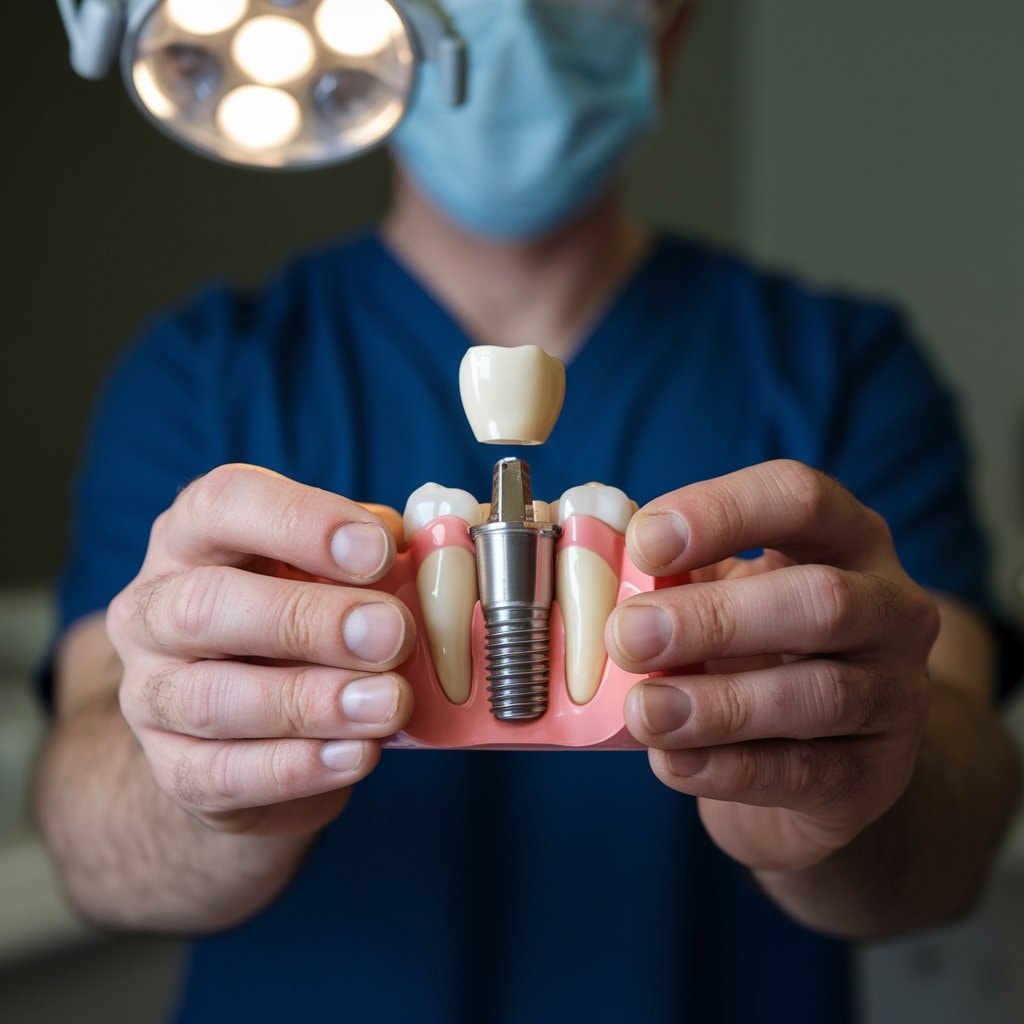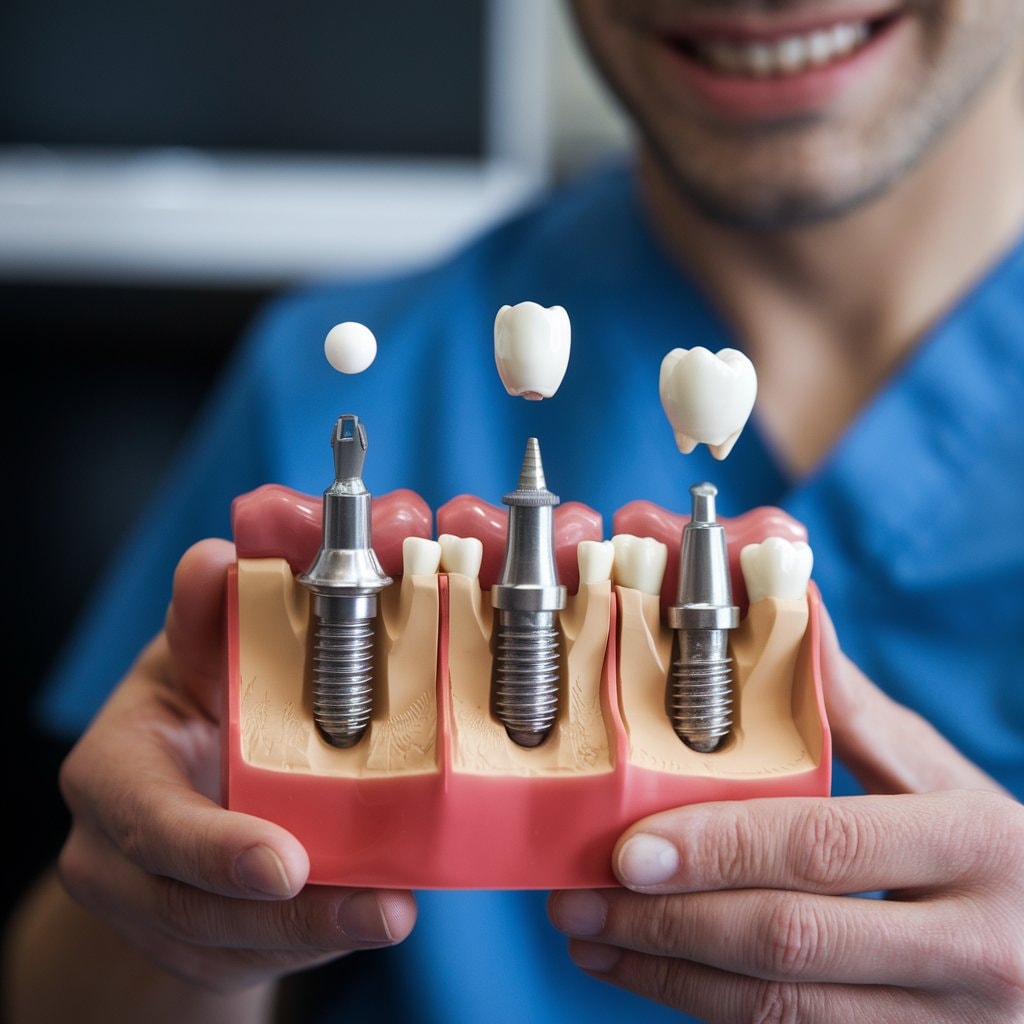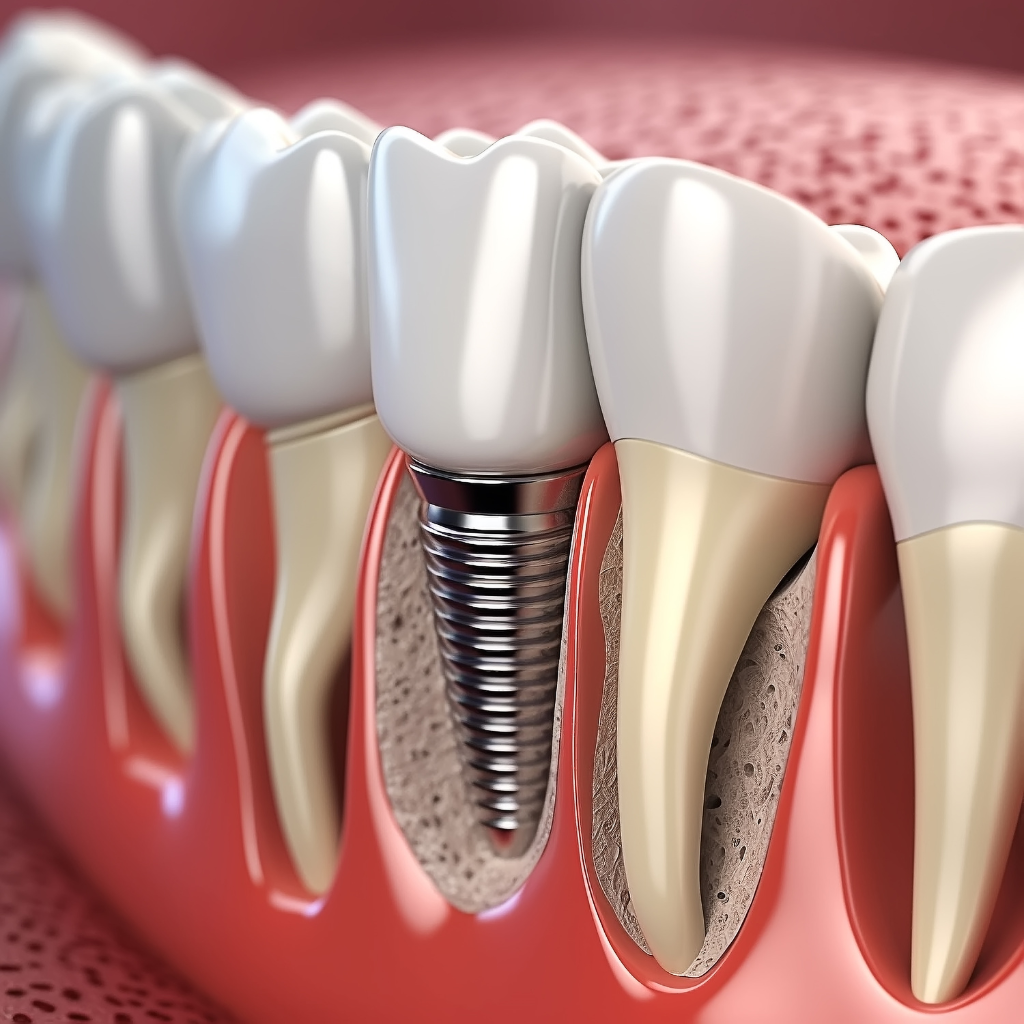Many people are looking for new ways to replace missing teeth without the drawbacks of traditional dental implants. Screwless dental implants might be the solution they’re searching for.
Unlike conventional methods, these innovative implants offer a fresh approach to restoring smiles with less risk and discomfort.
Screwless dental implants represent a significant advancement in implant dentistry, eliminating the need for screws that can lead to complications like loosening or visible screw holes.
This article will explore how screwless implant systems work, their benefits over standard options, and who an ideal candidate is. Discover a better way to treat missing teeth with us.
Keep reading to learn more!
What Are Screwless Dental Implants?
Screwless dental implants are a modern alternative to traditional implants that avoid the use of screws in securing the artificial tooth to the jaw bone. This approach eliminates concerns related to screw loosening, a common issue with screw-retained implants.
Instead of using screws, this method relies on bonding or adhesive materials that firmly attach the implant and abutment directly onto the patient’s natural bone. With this innovative system, patients experience improved aesthetics as there is no visible screw access hole.
This type of implant represents a significant advancement in dental treatment options for those missing one or more teeth. Screwless implants provide benefits, including reduced risk of implant failure due to screw complications and enhanced compatibility with natural dental tissues.
The absence of screws also minimises procedural invasiveness, making it an attractive option for many seeking tooth replacement solutions without the drawbacks associated with conventional methods.
Exploring the Screwless Implant System
Dentists use the screwless implant system to avoid problems like screw loosening or breakage, common with traditional implants. This new method focuses on creating a secure bond between the implant and bone without using screws.
It relies heavily on biocompatible materials such as titanium, which fuses well with bone tissue. The design aims for long-term Stability and reduces risks linked to oral health issues related to conventional implants.
The screwless system promises a leap forward in dental restoration by eliminating mechanical failures associated with screws.
This approach suits patients looking for durable solutions for missing teeth without the drawbacks of older methods. By bonding directly to the jawbone, these implants offer improved esthetics since there’s no visible metal part above the gum line.
They cater especially well to those experiencing high chewing forces or grinding teeth at night, providing a stable base that can withstand significant stress while maintaining natural tooth function.

Advantages Of Traditional Dental Implants
Screwless dental implants offer several key implant advantages over traditional dental implants. One major benefit is the reduced risk of screw loosening or fracture, which often complicates screw-retained implant systems.
Patients find that without the screws, their oral care routine becomes simpler and less prone to complications arising from hardware failure. This simplicity also extends to the aesthetic aspect; screwless implants typically provide a more natural appearance because they eliminate unsightly metal components at the gum line.
Furthermore, these innovative implants boast an improved success rate due to their design that promotes better osseointegration with the jawbone. The absence of a screw mechanism means there’s a lower chance for bacteria buildup around the implant site, leading to healthier gums and fewer infections.
For those experiencing bone loss or individuals looking for minimally invasive options, screwless dental implants emerge as an appealing solution by offering procedures that require less bone density and promote quicker recovery times compared to their traditional counterparts.
How Do Screwless Implants Work?
Screwless dental implants use a unique method that doesn’t rely on screws to attach the implant to the jawbone. This system involves an implant post and a dental prosthesis that fits directly over it.
The post, often made from titanium, fuses with the bone through a process known as osseointegration. This bond creates a stable foundation for the replacement tooth.
Dentists place the titanium implant into your jaw where you have missing teeth. Over time, your body’s natural healing process allows the bone to integrate directly with the implant surface, securing it in place without screws or cement.
Once healed, dentists then mount a custom-made dental prosthesis atop this post. The direct bonding between implant and bone ensures durability and reduces failure rates typically associated with screw fractures or excess cement issues in traditional implants.
Benefits of Screwless Dental Implant
Improved implant design and functionality stand as major benefits of screwless dental implants. This innovative system avoids problems like screw loosening, which can lead to implant failure.
Patients enjoy a lower rate of dental complications with these types of implants. Their unique structure allows for a better fit and Stability, enhancing the overall experience for those who receive them.
Enhancing implant treatment outcomes becomes much more achievable with screwless dental implants. These advanced options provide durable bonding, improving patients’ oral health in the long run.
They are particularly effective in areas with high aesthetic demands, such as front teeth, due to their seamless appearance. Moreover, the reduction in implant failure rates contributes significantly to patient satisfaction, offering a reliable solution for multiple missing teeth restoration without invasive procedures common in traditional methods.
Improved Implant Design and Functionality
Screwless dental implants signify the progressive shift in dentistry, promoting better patient results and upgraded implant functionality. These sophisticated implants, including the locking taper implant system, utilise innovative designs to eradicate the requirement for screws in affixing the implant to the jawbone.
This advancement reduces possible complications linked with screw-retained implants, such as loosening or breakage of the screw itself.
The secret to enhanced dental function lies beyond merely replacing a missing tooth and ensuring that the substitute operates seamlessly with natural teeth.
This inventive method also simplifies the installation procedure, rendering it less intrusive and more comfortable for patients. Dental experts now possess a polished tool that offers increased durability and reliability, addressing some of the most critical limitations of traditional implants.
Focusing on enhancing the bond between implants and bone, these systems strive for extended lifespan and imitate natural teeth more accurately than at any time in the past.
Enhancing Implant Treatment Outcomes
Enhancing the outcomes of implant treatments involves a concentration on the enduring success of screwless and cementless techniques. Experts utilise sophisticated materials like titanium, recognised for its congeniality with human bone, to uplift the survival rate of dental implants.
Current research suggests that these contemporary dentistry methods feature higher success rates compared to conventional ones. They support bonding implants’ durability to the jawbone, fostering superior oral health.
Dental practitioners frequently suggest screwless dental implants because they lower the probability of implant failure. The accuracy of the implantation process and the high-quality design decrease the usual dental predicaments associated with standard implants.
By selecting a method that ideally fits the patient’s oral cavity, dentists aim for more than just mending teeth but ensuring their longevity without additional complications. This approach secures enhanced functionality and aesthetics, making it a popular choice for those desiring to rejuvenate their smile effectively.
Reducing Implant Failure Rates
Dental implants without screws offer noteworthy advancements in minimising the failure rates of implants. The traditional dental implants had screws which could often result in complications like loosening over the period or even promote bacterial growth at the area of the screw.
By dismissing this component, screw-less implants provide fewer areas for infection or mechanical failure. These modifications result in an increased success ratio of dental restorations.
Patients who opt for the screw-less versions gain from a design that simulates natural teeth more efficiently. These particular implants assimilate with bone through a process termed osseointegration, thereby establishing a stable base without the requirement of screws.
The Outcome enhances aesthetics, durability and function beyond traditional methodologies. With these improvements, both patients and dental professionals can hope for improved long-term results from implant strategies.
Comparing Screwless Implants to Other Types
Screwless implants display distinctions from screw-retained implants and mini dental implants in a number of essential methods. In contrast to the regular screw-retained implant, a screwless structure removes the necessity for a tiny screw to fasten the crown to the implant base.
This reduction heightens aesthetic possibilities as there’s no apparent screw head or danger of it becoming unsecured as time goes on. Mini dental implants, though advantageous for specific scenarios owing to their reduced size, frequently don’t offer the equivalent level of reinforcement and endurance as their larger equivalents.
The core dissimilarity is based on the ways these types fuse with the jawbone. Screwless implants apply a friction-fit or locking taper system that formulates a powerful, steady connection without the use of screws.
This technique decreases complications linked with loosening or disrupting components within a system used for implants. In a comparative analysis of successful outcomes, this bonding approach contributes meaningful improvements in durability and potentially decreased failure rates than other types of dental prosthetics may undergo.

Screwless vs. Screw-Retained Implants
Choosing between screwless and screw-retained dental implants is a crucial decision for anyone considering dental restoration. Here’s a simple comparison to guide you through the key differences and advantages of each system.
| Feature | Screwless Implants | Screw-Retained Implants |
|---|---|---|
| Method of Attachment | Adhesive or friction fits directly to the abutment. | Attached with a screw to the abutment. |
| Aesthetic Outcome | Often more natural-looking since there’s no screw hole. | May have a small screw access hole that can be visible, affecting aesthetics. |
| Maintenance and Repairs | Can be more challenging to adjust or repair since it’s fixed. | Easier to remove for repairs or adjustments due to the screw mechanism. |
| Longevity and Stability | Highly dependent on the adhesive’s strength and the fit. | Screw allows for a secure and easily adjustable connection. |
| Risk of Complications | Lower risk of micro-movements since it’s directly bonded. | Potential for screw loosening or fracture under stress. |
The choice between screwless and screw-retained implants ultimately depends on individual needs, aesthetic preferences, and the specific recommendations of a dental professional. Moving forward, let’s examine the innovative techniques involved in the cementless restoration process.
Screwless vs. Mini Dental Implants
Understanding the differences between screwless and mini dental implants is essential for any dental patient or caregiver. We will provide a clear comparison.
| Feature | Screwless Dental Implants | Mini Dental Implants |
|---|---|---|
| Size | Larger than mini implants, resembling traditional implants in structure | Smaller and thinner, suitable for tight spaces and small gaps |
| Installation | Adheres directly to the jawbone without the need for screws | Screwed into place, requiring minimal surgery |
| Primary Use | Perfect for replacing full teeth with adequate bone support | Used for stability in dentures or in patients with insufficient bone mass |
| Recovery Time | May have longer healing time due to the nature of the implant | Shorter recovery period due to less invasive procedure |
| Longevity | Expected to last a lifetime with proper care | May require adjustments or replacement over time |
| Cost | Can be higher due to the technology and materials used | Generally more affordable due to smaller size and simplified procedure |
Both screwless and mini dental implants offer unique advantages depending on a patient’s needs, oral health status, and treatment goals.
Now, we will review the cementless technique for implant restoration.
Understanding the Implant Fixture Differences
After exploring the distinctions between screwless and mini dental implants, it becomes clear that understanding implant fixture differences is crucial. Implant fixtures serve as the anchor for dental prostheses.
They vary in design, which affects their integration with bone and overall success rate. Screw-retained implants rely on a mechanical connection to hold the prosthesis in place, while cementless techniques used in screwless systems eliminate the need for screws.
This difference significantly impacts implant survival rates, as each method has its unique way of bonding with bone tissue.
Every type of dental implant offers distinct advantages based on its fixture design; choosing the right one depends on multiple factors, including bone density, aesthetic limitations, and patient needs.
Locking taper implants are an example of screwless options providing a friction-fit connection without traditional screws. These types utilise pressure to secure the dental prosthesis directly to the jawbone, enhancing durability and reducing failure rates compared to some screw-retained systems.
The choice between these fixtures should consider individual treatment goals and specific dental problems each patient faces.
How Does the Cementless Technique for the Restoration Work?
The cementless technique for restoration uses titanium implants to replace missing teeth. This method offers a strong foundation without the need for screws or cement.
- Dentists first assess if a patient is an ideal candidate for screwless dental implant procedures. They look at factors like overall oral health and bone density.
- The next step involves surgically placing the titanium implant directly into the jawbone. Titanium is selected for its strength and compatibility with human tissues.
- Osseointegration, a critical phase, then follows. This process allows the bone to grow around and fuse with the implant, securing it in place over several months.
- After osseointegration, an abutment is attached to the top of the implant. Unlike traditional methods, this does not require screws or cement.
- Dental professionals then take impressions of the mouth and remaining teeth to create a custom dental prosthesis. This could be a crown, bridge, or denture.
- The crafted prosthetic is then fitted onto the abutment. Careful adjustments ensure comfort and functionality.
- Through this technique, bonding implants provide strength similar to natural tooth roots. Patients often experience improved speech and eating abilities.
- The cementless attachment helps reduce implant failure rates by eliminating potential complications from loose screws or improperly mixed cement.
- Long-term success depends on proper oral hygiene practices and regular dental check-ups to monitor the health of implants and surrounding tissues.
This approach supports modern dentistry’s goal of providing safe, durable solutions for tooth loss while maximising patient satisfaction through improved aesthetic outcomes and reduced repair limitations.
The Science Behind Osseointegrated Dental Implants
Osseointegrated dental implants have changed the game in oral implants. This process involves the direct structural and functional connection between living bone and the surface of a load-bearing artificial implant.
Typically made from titanium, these endosseous implants fuse with bone over time, creating a stable foundation for implant-supported restorations like crowns or bridges. The success of an implant hinges on its ability to integrate with the jawbone, making materials and methods critical factors.
Steps in successful osseointegration start with careful placement of the implant into a pre-drilled socket in the jawbone. Over months, the bone grows around and bonds to the rough surface of the titanium screw implant, securing it firmly in place.
This biological bonding process ensures the durability and longevity of dental restorations, directly impacting treatment outcomes positively. Next up is understanding how this foundation leads to improved design and functionality of screwless dental systems.

Steps in Implant Placement and Restoration
Screwless dental implants mark a notable development in the sphere of implant dentistry. They present an innovative alternative for individuals looking to fill gaps left by lost teeth, sidestepping the hassles linked to conventional screw-retained implants.
- Primary Evaluation: The journey begins with a comprehensive examination by an implant expert. In this meeting, the dentist will assess your dental health, cover various solutions for replacing lost teeth, and evaluate your suitability for a screwless dental implant.
- Formulating a Plan: Employing the latest imaging technologies, the dentist crafts a meticulous strategy for implant insertion. This step guarantees the implant’s fitting accuracy and its functionality akin to a natural tooth.
- Prepping the Implant Site: The next step involves the dentist grooming the implant site on the jawbone. This could mean minor modifications to ensure the highest level of fitting precision and successful osseointegration.
- Inserting the Screwless Implant: The dentist goes on to introduce the screwless dental implant into the jawbone surgically. Contrary to traditional approaches, this doesn’t necessitate screw tightening but depends on a direct bond between the implant and bone for longevity.
- Healing Phase: Post-insertion, a stage called osseointegration commences, wherein the jawbone begins to envelop the inserted post, forming a solid foundation for restoration. This phase can stretch over several months.
- Attaching the Abutment: Upon completion of osseointegration, an abutment is affixed to the implant’s upper part. This component acts as an intermediary between the implant and the ultimate restoration.
- Final Restoration Procedure: The concluding step is about fitting custom prosthetics like crowns or bridges to the abutment. These restorations are made to mimic your natural teeth in terms of colour, shape, and size to bypass any cosmetic concerns.
- Post-Treatment Supervision: Regular follow-up appointments facilitate your dentist’s scrutiny of your new tooth’s Stability and incorporation within your oral environment, bolstering the life expectancy of the employed implant systems.
Running through these stages, patients are provided care that is precisely attuned to the best possible treatment results and minimises the risk of implant failure. This clarity is the reason for a growing preference for screwless implants over other options available.
Long-term Success of Screwless Implant Systems
After covering the procedures for implant placement and restoration, the importance of screwless implants for long-term success rates should be underscored. There’s a notable benefit seen by dental professionals with screwless dental implant systems, thanks to their construction that aligns more comfortably with the patient’s oral makeup.
This fit often causes lower failure rates than implants that use conventional screws. Research has indicated that these progressions result in superior durability and dependability over numerous years, providing a durable solution for individuals with missing teeth.
Screwless dental implants provide a modern method ensuring enduring Stability and success.
Clinicians also mention simpler upkeep and fewer problems during return visits, which goes a long way in showing the practical advantages of opting for screwless versions. Patients appreciate a more visually appealing outcome as well as improved comfort and usability – vital components that lead to patient contentment and the overall success of the treatment.
What Are the Cost Considerations?
Evaluating the costs for screwless dental implants takes into account numerous factors influencing the final price. This includes the implant type, the quantity of teeth to be replaced, and the intricacy of the procedure.
Despite the premium initial cost of screwless implants – owing to their cutting-edge technology and potential to last longer – compared to conventional screw-retained implants, the benefits could outweigh the cost.
Factors such as the dentist’s experience and material quality can also influence both the cost and the success rates.
Insurance coverage diversity for screwless dental implant procedures can pose a challenge. It’s common for many plans to exclude full coverage for implant treatments, resulting in patients bearing the cost personally or exploring financing alternatives.
It’s critical for patients to thoroughly converse about the cost with their dental provider to gain a clear understanding of all possible expenses. This discussion should cover more than just the initial placement but also encompass potential future maintenance or adjustments that may require further expenditure.
Factors Influencing the Cost of Implant Dentistry
The cost of implant dentistry varies widely, and several factors play a crucial role. The type of dental implant system used is one major factor. For instance, screwless implants may have different pricing compared to traditional screw-retained implants or mini dental implants due to the technology and materials involved.
Another significant aspect is the complexity of the individual’s oral health condition. Patients requiring additional treatments, such as bone grafts or those with complex cases, might see higher costs.
Materials chosen for the implant also affect the price. Options range from titanium to zirconia, each with its cost implications. Location plays a role, too, since dental practices In urban areas, costs are often higher due to operating costs.
Lastly, the experience and expertise of the dentist can influence fees; highly skilled professionals may command premium prices for their services in implant placement and restoration procedures.
Who Are Ideal Candidates for Screwless Dental Implants?
Screwless dental implants offer a modern solution for replacing missing teeth. They are especially suitable for patients looking for reliable, long-lasting tooth replacement options without the complications of traditional screw-retained implants. Here’s who might consider them:
- Adults with one or more missing teeth can benefit from screwless dental implants to restore their smile and bite.
- People who have experienced issues with previous dental implants, such as loosening or infection around the implant site, may find screwless options more stable and less prone to problems.
- Individuals desiring a quicker recovery period will appreciate that screwless implant systems often involve less invasive procedures, leading to faster healing times.
- Those with a low pain threshold might prefer screwless implants since the placement process tends to be less painful compared to traditional methods.
- Patients concerned about the screw implants’ aesthetic limitations will find that screwless implants offer superior cosmetic outcomes.
- People with a high risk of dental implant failure due to conditions like osteoporosis could benefit from the enhanced bonding and durability of screwless systems.
- Candidates who value longevity in dental restorations should consider screwless options, given their promising success rates.
- Someone looking for an implant solution that minimises maintenance challenges might opt for screwless designs due to their streamlined structure and fewer components.
- Patients requiring single-tooth replacements may find that a single-tooth implant using the screwless method offers precise results with minimal disruption to surrounding teeth.
- Dental patients seeking affordable implant prosthetics will want to explore cost considerations; while some insurance plans cover these procedures, overall treatment expenses can vary based on individual needs.
Ideal candidates include those interested in exploring innovative dental solutions that blend comfort, durability, and aesthetic appeal in tooth restoration processes.
Assessing Missing Teeth Replacement Options
Investigating choices for filling in gaps from lost teeth is essential for reviving your grin and oral well-being. Treatments like dental inserts, including progressive screw-less implant systems, ring a bell as brilliant alternatives compared to different solutions like dentures or bridges.
Each choice brings its own set of advantages and important factors. Take dental implants, for example; they present an enduring solution that, with appropriate care, can persist for a lifetime.
They effectively mirror natural teeth in visual appeal and function, making them a favoured choice for both patients and dental professionals.
Aiding in this investigation, a discussion with an implant specialist can illuminate the treatment method that best aligns with your requirements. Elements like bone density, the position of lost teeth, and overall oral health are crucial in deciding the optimal implant choice for you.
Screw-less dental implants might be suggested as their cosmetic restrictions are far less visible compared to screw-retained implants. While making a choice, the entire procedure involves pondering the long-term success rates of dental implants, which portray high dependability over time.
All in all, evaluating each possible tooth replacement options ensure an informed decision with regard to your unique circumstances.
Consultation with an Implant Specialist
Choosing the right implant starts with a detailed consultation with an implant specialist. This step is crucial for assessing your unique dental needs and exploring which type of implant, screwless or otherwise, suits you best.
The specialist will examine your oral health thoroughly, considering factors like bone density, gum health, and the overall condition of natural teeth that play a significant role in implant selection.
They use advanced diagnostic tools to plan precise implant placement that promises durability and aesthetic appeal.
During this visit, discussions about the cost of different implants, including screwless systems used in dental practices today, are common. Patients learn about the long-term success rates of various dental implants and how each option fits into their oral hygiene routine.
A key point often highlighted by specialists is that only some patients may be suitable for screwless dental implants due to specific clinical conditions or requirements.
The aim is not only to replace missing teeth but to provide restorations that mimic natural tooth function while ensuring comfort and confidence for the patient, says Dr Suresh Mohan Kumar.
Understanding the Role of Natural Teeth in Implant Selection
After discussing the importance of consulting with an implant specialist, it is crucial to consider how your natural teeth are crucial in selecting implants. Natural teeth can guide dentists in choosing the right implant options for you.
For instance, their size, colour, and position help in making decisions about the type of implant that will match and function well with your existing dental structure. This ensures that any new addition looks seamless and works harmoniously with what is already there.
Moreover, assessing the health of your natural teeth also matters. Healthy surrounding teeth serve as strong supporters for new implants. They make sure that the implant has a stable base to attach to.
This assessment helps in reducing failure rates of implants by ensuring they’re placed where they have the best chance for long-term success. Dentists use this information, along with factors like jawbone density, to plan out treatment steps carefully.
Conclusion
Choosing the right implant, be it a screwless or mini dental implant, hinges on your unique needs and oral health status. Understanding the contrasts among various implants can assist in making an educated decision.
Screwless dental implants present distinct advantages, such as an enhanced design and reduced risk of failure. They shine as a durable choice in the field of implant dentistry.
The best candidates for screwless dental implants are those searching for dependable alternatives to traditional restorations. Through a discussion with an implant specialist, you can ascertain if this modern method fits your circumstances.
Screwless systems play a crucial role in the success rate of dental implants by offering stable and visually pleasing solutions for replacing missing teeth.


